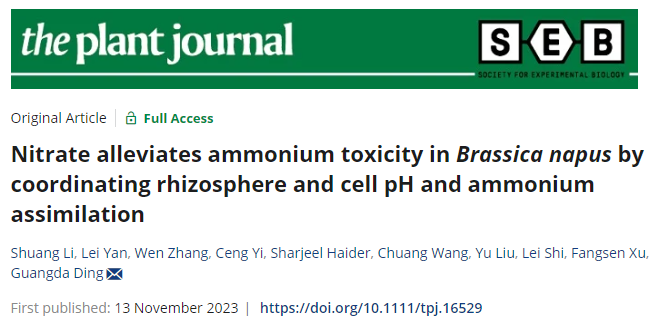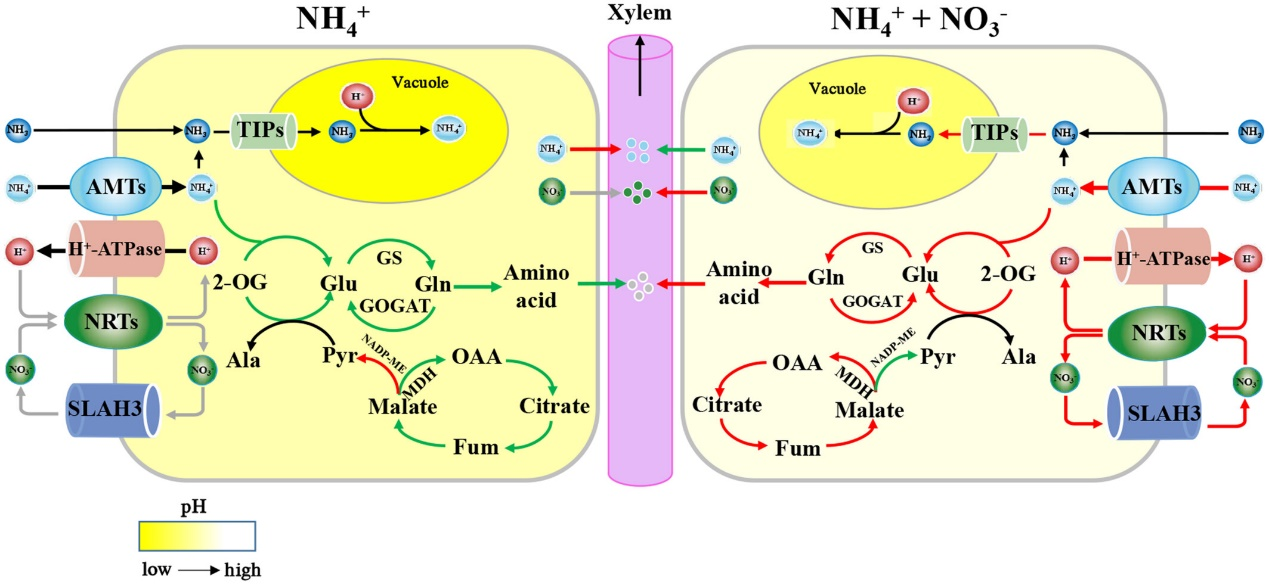南湖新闻网讯(通讯员 李双)在自然和农业条件下,铵是植物首选的氮源,但过量可能对植物有害,称为铵毒。硝态氮长期以来一直被认为可以降低铵毒。甘蓝型油菜是一种对高铵敏感的重要油料作物。然而,人们对甘蓝型油菜中硝态氮缓解铵毒的机制知之甚少。11月13日,The Plant Journal在线发表了题为“Nitrate alleviates ammonium toxicity in Brassica napus by coordinating rhizosphere and cell pH and ammonium assimilation”的研究论文。该研究揭示了硝态氮通过协调根际和细胞pH和铵同化作用减轻甘蓝型油菜铵毒的生物学机制。

氮是植物生长发育必需的大量营养元素。一般而言,硝态氮和铵是农业中用于维持作物生长发育的两种主要无机氮源,它们在天然和农业土壤中的浓度通常比其他氮源高得多。铵被植物根系吸收后可直接同化成氨基酸被植物利用,而硝态氮则需先还原成铵,然后再进行同化利用。因此,与硝态氮相比,植物对铵态氮的利用过程更加节能。因此,铵态氮被认为是许多作物的首选氮源,特别是那些生长在缺氧或酸性土壤中的作物。然而,当铵态氮作为唯一氮源的时候,高浓度的铵态氮往往会抑制作物的生长,这种现象被称为铵毒。研究表明,硝态氮可以缓解植物铵毒。油菜是我国重要的油料作物。前期研究发现,与铵态氮相比,甘蓝型油菜更偏好硝态氮,且不同氮效率品种对铵硝氮源的响应存在显著的基因型差异(Li et al. Plant Physiology and Biochemistry, 2021, 166: 348–360)。同时,铵态氮作为唯一氮源会显著抑制油菜的生长。在高铵处理下,油菜叶片中碳氮代谢失衡,光合电子传递链受损,活性氧过度积累(Li et al. Environmental and Experimental Botany, 2021, 189: 104550)。研究发现,硝态氮可以缓解油菜铵毒。为进一步解析其机制,该研究联合转录组、代谢组和生理分析,发现硝态氮可以通过平衡根际和细胞内pH并加速甘蓝型油菜的铵同化来减轻铵的毒性。在高铵环境下,硝态氮通过增强AMT和NRT转运蛋白的表达来增加铵硝的吸收,且通过促进硝态氮外排转运蛋白SLAH3和质子泵编码基因的表达来增强硝态氮和质子从细胞质到质外体的外排。此外,硝态氮增加了细胞质、液泡和根际的pH,并下调了酸胁迫诱导基因的表达。在高铵条件下,硝态氮提高了油菜根系中谷氨酰胺合成酶(GS)的活性,促进了铵向氨基酸的同化,从而减少了铵在油菜中的积累和向地上部的迁移。研究发现,根系中GS的活性高度依赖于环境pH。此外,硝态氮可能在三羧酸循环中诱导参与氨基酸生物合成和苹果酸代谢的代谢产物,并抑制苯丙烷代谢以减轻铵的毒性。总之,该研究表明,硝态氮通过有效的铵、硝和质子的跨膜循环平衡根际和细胞内pH,加速铵同化,并上调苹果酸代谢,以减轻油菜铵毒。

硝态氮减轻甘蓝型油菜铵毒的工作模型
我校资源与环境学院已毕业博士生李双为论文第一作者,丁广大教授为论文通讯作者。该研究受到国家重点研发计划项目(2022YFD1900705)和湖北省自然科学基金项目(2021CFB458)的资助。
审核人:丁广大
英文摘要:
In natural and agricultural situations, ammonium (NH4+) is a preferred nitrogen (N) source for plants, but excessive amounts can be hazardous to them, known as NH4+ toxicity. Nitrate (NO3-) has long been recognized to reduce NH4+ toxicity. However, little is known about Brassica napus, a major oil crop that is sensitive to high NH4+. Here, we found that NO3- can mitigate NH4+ toxicity by balancing rhizosphere and intracellular pH and accelerating ammonium assimilation in B. napus. NO3- increased the uptake of NO3- and NH4+ under high NH4+ circumstances by triggering the expression of NO3- and NH4+ transporters, while NO3- and H+ efflux from the cytoplasm to the apoplast was enhanced by promoting the expression of NO3- efflux transporters and genes encoding plasma membrane H+-ATPase. In addition, NO3- increased pH in the cytosol, vacuole, and rhizosphere, and down-regulated genes induced by acid stress. Root glutamine synthetase (GS) activity was elevated by NO3- under high NH4+ conditions to enhance the assimilation of NH4+ into amino acids, thereby reducing NH4+ accumulation and translocation to shoot in rapeseed. In addition, root GS activity was highly dependent on the environmental pH. NO3- might induce metabolites involved in amino acid biosynthesis and malate metabolism in tricarboxylic acid cycle, and inhibit phenylpropanoid metabolism to mitigate NH4+ toxicity. Collectively, our results indicate that NO3- balances both rhizosphere and intracellular pH via effective NO3- transmembrane cycling, accelerates NH4+ assimilation, and up-regulates malate metabolism to mitigate NH4+ toxicity in oilseed rape.
